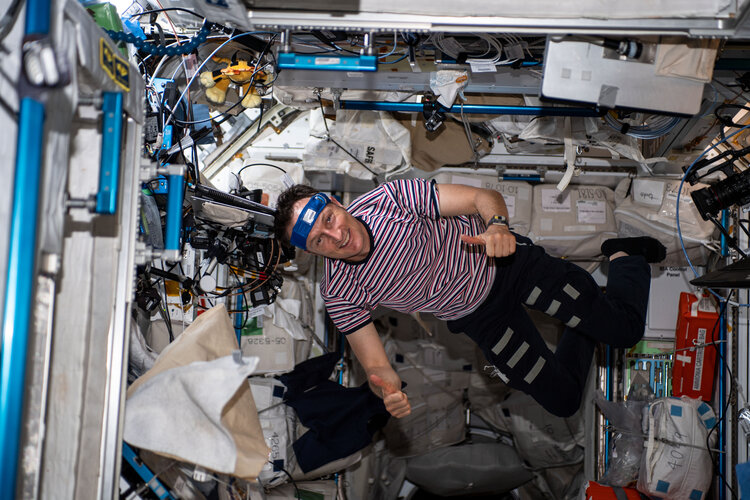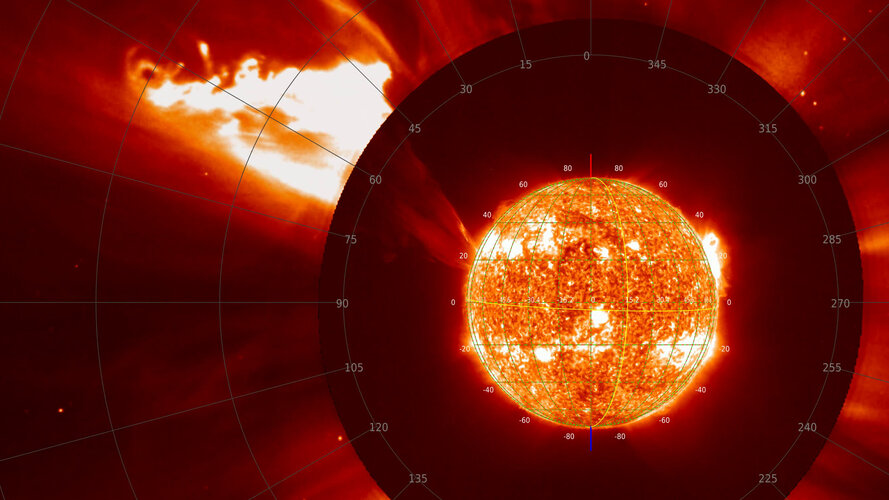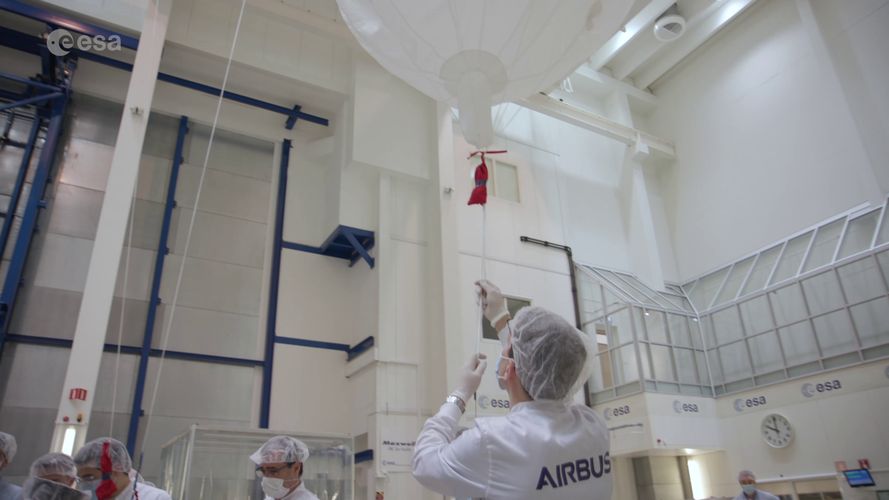Getting ready for lunar orbit
Friday, 18 February 2022 13:12 Image:
Image:
ESA astronaut Alexander Gerst visited Thales Alenia Space in Turin recently to test out and provide feedback on accommodations for the next human outpost in space, the lunar Gateway.
As the name implies, the Gateway will be located within the Moon’s orbit and is being built by Thales Alenia Space on behalf of ESA. Among its components is the International Habitation Module or I-Hab.
As crew quarters are designed with humans in mind, Alex both toured the mock-up and stepped into the crew quarter simulator to provide some experienced feedback. After two missions to the International Space Station – Blue
Gateway virtual reality session
Friday, 18 February 2022 13:12 Image:
Gateway virtual reality session
Image:
Gateway virtual reality session Week in images: 14 - 18 February 2022
Friday, 18 February 2022 13:06
Week in images: 14 - 18 February 2022
Discover our week through the lens
Blue Origin to increase New Shepard launches in 2022
Friday, 18 February 2022 11:53
Blue Origin expects to more than double the number of people it flies on its New Shepard suborbital system this year while adding another vehicle to its fleet.
The post Blue Origin to increase New Shepard launches in 2022 appeared first on SpaceNews.
Earth from Space: Tenerife, Canary Islands
Friday, 18 February 2022 08:00
The Copernicus Sentinel-2 mission takes us over Tenerife – the largest of Spain’s Canary Islands.
100 days of Cosmic Kiss science
Friday, 18 February 2022 08:00
Saturday 19 February marks 100 days since ESA astronaut Matthias Maurer was launched to the International Space Station for his first mission, Cosmic Kiss. He launched on a SpaceX Dragon spacecraft with NASA astronauts Kayla Barron, Raja Chari and Tom Marshburn as a member of Crew-3. But even before he was launched to space, he was subject to scrutiny for science.
Giant solar eruption seen by Solar Orbiter
Friday, 18 February 2022 07:30
The ESA/NASA Solar Orbiter spacecraft has captured the largest solar prominence eruption ever observed in a single image together with the full solar disc.
100 days of Cosmic Kiss
Friday, 18 February 2022 07:00 Video:
00:04:40
Video:
00:04:40
English - 100 days of Cosmic Kis
On 11 November 2021, ESA astronaut Matthias Maurer was launched to the International Space Station for his first mission, Cosmic Kiss. Around 100 days later, we reflect on some highlights from space.
Matthias flew to the Station on a SpaceX Crew Dragon alongside NASA astronauts and fellow first-time fliers Kayla Barron and Raja Chari, and NASA spaceflight veteran Tom Marshburn. Collectively known as Crew-3, they were welcomed as members of Expedition 66 by Commander Anton Shkaplerov, cosmonaut Pyotr Dubrov and NASA’s Mark Vande Hei.
While in orbit, Matthias is supporting over 35 European
Balloon boom
Friday, 18 February 2022 07:00 Video:
00:01:02
Video:
00:01:02
The 3 m-long magnetometer boom of the Solar wind Magnetosphere Ionosphere Link Explorer (Smile) is deployed under helium-filled balloons to simulate the weightlessness conditions of space.
Smile is a joint mission between ESA and the Chinese Academy of Sciences (CAS) and will aim to build a more complete understanding of the Sun-Earth connection by measuring the solar wind and its dynamic interaction with the magnetosphere.
The structural and thermal model of the Smile payload module is currently undergoing testing at the European Space Research and Technology Centre (ESTEC) in Noordwijk, the Netherlands. Missions frequently come ‘home’ to ESA’s technical
Europe needs a crewed space vehicle, astronauts say
Friday, 18 February 2022 05:11 Europe needs its own crewed spaceship to build its space industry and talent, astronauts who gathered in France said in an official manifesto Wednesday.
Dozens of astronauts endorsed the statement that "we need to be able to count on our own autonomous access to space for humans," according to the manifesto presented at the 2022 European Space Summit in Toulouse.
It calls on Euro
Europe needs its own crewed spaceship to build its space industry and talent, astronauts who gathered in France said in an official manifesto Wednesday.
Dozens of astronauts endorsed the statement that "we need to be able to count on our own autonomous access to space for humans," according to the manifesto presented at the 2022 European Space Summit in Toulouse.
It calls on Euro Research project examines how humans live in space
Friday, 18 February 2022 05:11 As long-distance space travel transforms from a science fiction fantasy to a near-future reality, humanity is faced with a complex challenge: Can people socially and culturally adapt to and survive spending years hurtling across the universe in a contained, artificial space?
Shawn Graham, a digital archaeologist and historian at Carleton University, is working with the International Space
As long-distance space travel transforms from a science fiction fantasy to a near-future reality, humanity is faced with a complex challenge: Can people socially and culturally adapt to and survive spending years hurtling across the universe in a contained, artificial space?
Shawn Graham, a digital archaeologist and historian at Carleton University, is working with the International Space Blue Origin to build more rockets amid expectations to tourist flights
Friday, 18 February 2022 05:11 Jeff Bezos' Blue Origin space company says it will have to build more of its New Shepard rockets in order to meet the "very robust demand" for space tourism, the company's CEO said.
At the FAA Commercial Space Transportation Conference in Washington, DC, on Thursday, Blue Origin CEO Bob Smith said the company had "thousands of people in the auction process" for tickets, indicating "very ro
Jeff Bezos' Blue Origin space company says it will have to build more of its New Shepard rockets in order to meet the "very robust demand" for space tourism, the company's CEO said.
At the FAA Commercial Space Transportation Conference in Washington, DC, on Thursday, Blue Origin CEO Bob Smith said the company had "thousands of people in the auction process" for tickets, indicating "very ro Coca-Cola launching new Starlight drink 'inspired by space'
Friday, 18 February 2022 05:11 A new flavor of Coca-Cola is coming soon - a promotional announcement from Coca-Coca Thursday said, "From the furthest reaches of the galaxy, Coca-Cola Starlight is arriving."
The new limited edition drink, called Coca-Cola Starlight, features a taste the beverage maker calls unique, and will be offered in both regular and zero sugar and is expected to be available Feb. 21.
In a pres
A new flavor of Coca-Cola is coming soon - a promotional announcement from Coca-Coca Thursday said, "From the furthest reaches of the galaxy, Coca-Cola Starlight is arriving."
The new limited edition drink, called Coca-Cola Starlight, features a taste the beverage maker calls unique, and will be offered in both regular and zero sugar and is expected to be available Feb. 21.
In a pres Terran Orbital to build microsatellite program
Friday, 18 February 2022 05:11 Small-satellite pioneer Terran Orbital Corporation ("Terran Orbital") was awarded a contract by Lockheed Martin Aeronautics to provide three microsatellite class satellites, launch procurement, integration, and operations in support of product demonstration.
"We are thrilled Terran Orbital will be part of another program with Lockheed Martin. This contract award provides an exciting opport
Small-satellite pioneer Terran Orbital Corporation ("Terran Orbital") was awarded a contract by Lockheed Martin Aeronautics to provide three microsatellite class satellites, launch procurement, integration, and operations in support of product demonstration.
"We are thrilled Terran Orbital will be part of another program with Lockheed Martin. This contract award provides an exciting opport Preventing Lunar traffic jams
Friday, 18 February 2022 05:11 The moon is top of mind for many national space programs and private companies, with some planning to send humans back to the lunar surface as early as 2025.
In advance, scientists are launching satellites and other payloads to orbit the moon. But so far, no one has kept track of just how many artificial objects are already up there, or where they are at any given moment. Without a way to
The moon is top of mind for many national space programs and private companies, with some planning to send humans back to the lunar surface as early as 2025.
In advance, scientists are launching satellites and other payloads to orbit the moon. But so far, no one has kept track of just how many artificial objects are already up there, or where they are at any given moment. Without a way to 
